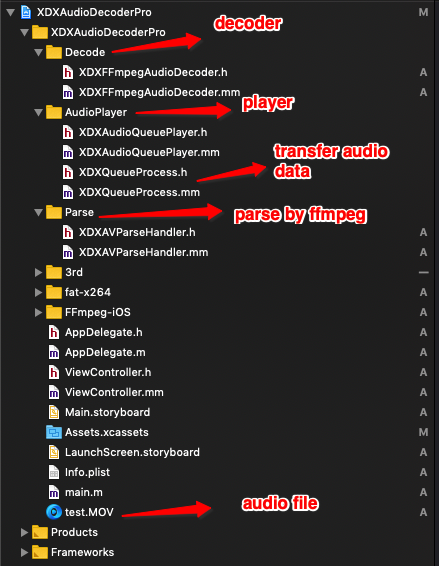需求
利用FFmepg解析并解码音频流数据,然后将解码后的音频数据送给Audio Queue以实现播放.
实现原理
利用FFmpeg解析音频数据流, 利用FFmpeg解码音频数据为PCM格式. 利用Audio Queue Player实现音频数据播放.
阅读前提
代码地址 : Audio Decoder
掘金地址 : Audio Decoder
简书地址 : Audio Decoder
博客地址 : Audio Decoder
总体架构
本例以一个苹果原生相机录制的.MOV文件为例, 将该文件使用FFmpeg解析并解码,将解码后的数据放入传输队列中,然后开启audio queue player, 播放器在回调函数中轮循取出队列中的数据实现播放.
简易流程
FFmpeg parse流程
- 创建format context:
avformat_alloc_context - 打开文件流:
avformat_open_input - 寻找流信息:
avformat_find_stream_info - 获取音视频流的索引值:
formatContext->streams[i]->codecpar->codec_type == (isVideoStream ? AVMEDIA_TYPE_VIDEO : AVMEDIA_TYPE_AUDIO) - 获取音视频流:
m_formatContext->streams[m_audioStreamIndex] - 解析音视频数据帧:
av_read_frame
FFmpeg解码流程
- 从parse中的
AVFormatContext获取音频流对象AVStream.m_formatContext->streams[m_audioStreamIndex]; - 获取解码器上下文:
formatContext->streams[audioStreamIndex]->codec - 获取解码器实例:
avcodec_find_decoder(codecContext->codec_id) - 打开解码器:
avcodec_open2 - 初始化音频帧:
AVFrame *av_frame_alloc(void); - 将数据发给解码器:
int avcodec_send_packet(AVCodecContext *avctx, const AVPacket *avpkt) - 获取解码后的数据:
int avcodec_receive_frame(AVCodecContext *avctx, AVFrame *frame); - 创建转码器:
struct SwrContext *swr_alloc(void); - 设置转码器参数:
swr_alloc_set_opts - 初始化转码器上下文:
int swr_init(struct SwrContext *s) - 开始转码:
int swr_convert(struct SwrContext *s, uint8_t **out, int out_count,const uint8_t **in , int in_count); - 获取转码后的data与size.
文件结构
快速使用
设置音频格式ASBD
1
2
3
4
5
6
7
8
9
10AudioStreamBasicDescription audioFormat = {
.mSampleRate = 48000,
.mFormatID = kAudioFormatLinearPCM,
.mChannelsPerFrame = 2,
.mFormatFlags = kLinearPCMFormatFlagIsSignedInteger | kLinearPCMFormatFlagIsPacked,
.mBitsPerChannel = 16,
.mBytesPerPacket = 4,
.mBytesPerFrame = 4,
.mFramesPerPacket = 1,
};配置播放器
1
[[XDXAudioQueuePlayer getInstance] configureAudioPlayerWithAudioFormat:&audioFormat bufferSize:kXDXBufferSize];
Parse并解码音频文件数据
1
2
3
4
5
6
7
8
9
10
11
12
13
14
15
16- (void)startDecode {
NSString *path = [[NSBundle mainBundle] pathForResource:@"test" ofType:@"MOV"];
XDXAVParseHandler *parseHandler = [[XDXAVParseHandler alloc] initWithPath:path];
XDXFFmpegAudioDecoder *decoder = [[XDXFFmpegAudioDecoder alloc] initWithFormatContext:[parseHandler getFormatContext] audioStreamIndex:[parseHandler getAudioStreamIndex]];
decoder.delegate = self;
[parseHandler startParseGetAVPackeWithCompletionHandler:^(BOOL isVideoFrame, BOOL isFinish, AVPacket packet) {
if (isFinish) {
[decoder stopDecoder];
return;
}
if (!isVideoFrame) {
[decoder startDecodeAudioDataWithAVPacket:packet];
}
}];
}获取解码后数据并播放
为了每次能够重新播放,这里需要标记当前是否为解码的第一帧数据,以重新启动播放器. 另一点是使用NSTimer等待音频数据放入队列再开始播放,因为audio queue是驱动播放模式,所以必须等音频数据放入传输队列再开始播放.
1 | #pragma mark - Decode Callback |
具体实现
1. 初始化解码器
从Parse模块中可以获取当前文件对应FFmepg的上下文对象AVFormatContext.因此音频流解码器信息可以直接获取.
获取音频流对象
1
AVStream *audioStream = m_formatContext->streams[m_audioStreamIndex];
获取解码器上下文对象
1
2
3
4
5
6
7
8
9
10
11
12
13
14
15- (AVCodecContext *)createAudioEncderWithFormatContext:(AVFormatContext *)formatContext stream:(AVStream *)stream audioStreamIndex:(int)audioStreamIndex {
AVCodecContext *codecContext = formatContext->streams[audioStreamIndex]->codec;
AVCodec *codec = avcodec_find_decoder(codecContext->codec_id);
if (!codec) {
log4cplus_error(kModuleName, "%s: Not find audio codec",__func__);
return NULL;
}
if (avcodec_open2(codecContext, codec, NULL) < 0) {
log4cplus_error(kModuleName, "%s: Can't open audio codec",__func__);
return NULL;
}
return codecContext;
}初始化音频帧
AVFrame 作为解码后原始的音视频数据的容器.AVFrame通常被分配一次然后多次重复(例如,单个AVFrame以保持从解码器接收的帧)。在这种情况下,av_frame_unref()将释放框架所持有的任何引用,并在再次重用之前将其重置为其原始的清理状态。
1 | // Get audio frame |
2. 将原始数据发给解码器
调用avcodec_send_packet将压缩数据发送给解码器.最后利用循环接收avcodec_receive_frame解码后的音视频数据.
1 | int result = avcodec_send_packet(audioCodecContext, &packet); |
3. 接收解码后的数据.
1 | result = avcodec_receive_frame(audioCodecContext, audioFrame); |
4. 将解码后的数据转码为iOS设备可播放的类型
1 | result = avcodec_receive_frame(audioCodecContext, audioFrame); |


